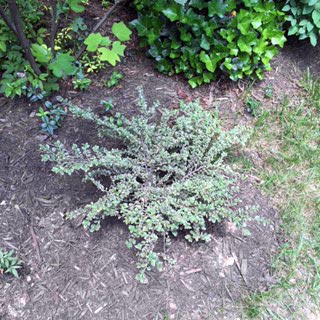The Hunt for Variegated Cotoneaster
Strange odyssey takes author to forgotten lands at garden centers and a rare expedition to … Maryland
By George Graine, Fairfax Master Gardener
“To make a great garden, one must have a great idea or a great opportunity.”
—Sir George Sitwell in “Essay on the Making of Gardens” (1909)
The renowned Michael A. Dirr has described it his way, “Cotoneaster horizontalis ‘Variegatus:’ Leaves are edged with white, turn rose red in autumn; considered one of the daintiest of variegated shrubs.”
From my experience, it is certainly one of the slowest growing and hardest to find plants. The hunt for the variegated cotoneaster was undoubtedly the most elusive of all my plant searches.
It began many years ago when a small-leaf variegated cotoneaster was available at the annual Virginia Master Gardener College Silent Auction in a one-gallon pot. This was an interesting plant that looked similar to a small green leaf cotoneaster called Tom Thumb. For reasons I cannot fathom, the bidding on this plant became so outrageously high that it resulted in my reluctance to play for pay. The final bid far exceeded a typical retail price. Although the auction money went to a good cause, I withdrew from the bidding.

The author’s prized variegated cotoneaster
After a few years my special plant was not doing well. Apparently it was being overtaken by fast growing plants, and the variegated cotoneaster was unable to tolerate this intrusion in the space I had originally allocated. Maybe it was being sun starved, too, but to relocate this plant would have created heartache. Disappointed again, I watched as this trophy plant expired.
Now fast forward at least four years from this earlier experience. The wholesale catalog of a nearby garden center indicated that it had variegated cotoneaster in three-gallon pots. Great! I hustled down to close the missing link, so to speak, for my plant collection. But again, I confronted disappointment. I was met with the “no such plant exists” routine, and to add further insult “we have never carried it on the lot.” The second statement was, of course, redundant if the first statement was true. This really irritated me, but I kept my calm and showed the ignorant employee the catalog. It clearly indicated this plant exists, and the garden center’s inventory listed it in a three-gallon pot. I said “No thanks” when I was told they could special order a plant.
Later, in a eureka moment (I was really desperate and annoyed), and with the help of the Internet I found another large full service garden center (not where the original purchase was made) that carried variegated cotoneaster in two-gallon pots. Was I willing to take on another disappointment? Fact is I became more determined than ever to find the plant that seemed to confound the otherwise competent garden centers.
Driving across the Virginia state line into the exotic state of Maryland, I was smug with satisfaction, having been assured this garden center had variegated cotoneaster in a two-gallon pot. It was an easy drive to this never-visited garden center, and when I got there, I was, indeed, impressed with the variety of plants and tidiness. As I walked around, several thoughts came to me. Did I make a foolish trip? Was I suckered just to visit the nursery? More importantly, did they really have variegated cotoneaster? I noticed the prices were on the high side compared to Virginia, but this was consistent with the suburban Maryland location. By this time, and remembering my past frustrations, I decided price would be no object. Did I care if my children would not inherit an extra 30-50 bucks?
Now the real adventure begins. The first and then the second employee I talked to gave me a “Hmmm…Let me see” as the second finally found the cotoneaster collection. Oh darn! Not a variegated cotoneaster in the bunch. Depression set in as memories of similar experiences came rushing back to my mind. Annoyed, I was about to high tail it out of there when the second employee spotted a guy packing a Felco pruner and other tools of the trade hanging on his belt. This worker, clearly a pro, said, “Sure we have variegated cotoneaster -– follow me.” It turns out they were in a different location. I did not bother to ask why. Incredibly, the garden center had four plants in great shape, all in two-gallon Monrovia pots and with full explanatory plant tags. Almost speechless, I thanked the man and selected a plant.
Although I was in a foreign horticultural land, I came prepared; I was wearing my contractor polo shirt when I walked up to the cashier with plant in hand. “Do you accommodate people in the trade,” I asked? Not a problem. The cashier rang up my purchase which included a 20% discount. I was elated! I suppose the discount paid for the extra gas, but it also contributed to my euphoria.
Now as is often the case with gardeners, I needed to address the problem of where to put the plant, especially considering the location of the expired variegated cotoneaster. Not to worry, I said to myself. I will figure that out and make sure this plant will be front and center so that every time I walk by I will smile and think –- yes, the wait was worth it.
Reference
Manual of Woody Landscape Plants, by Michael A. Dirr